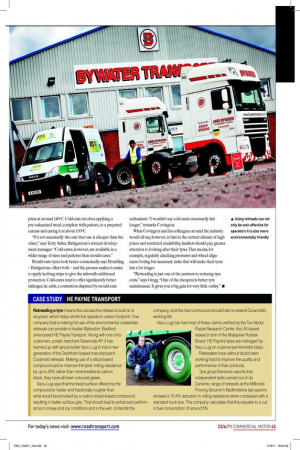Treading carefully
Page 38

Page 39

If you've noticed an error in this article please click here to report it so we can fix it.
As new tyre prices soar, CM looks at the types of retread available, and other ways hauliers can save money on their tyres Words: Steve Banner Hauliers faced with soaring bills for new truck
tyres, thanks to escalating raw material prices, could be forgiven for opting for less-expensive retreads. Tyre maker Goodyear Dunlop, for example, increased new tyre prices by 11% in 2010 and had posted a 16% rise this year at the time of writing. Other tyre makers have followed suit.
New truck tyres are also in short supply in the UK due to rising demand in some European countries as their economies recover, says Arthur Gregg, sales and marketing director, commercial, at tyre supplier Continental.
On top of this some budget-price Asian manufacturers have withdrawn from Europe, believing they can sell their products more proitably elsewhere. Indigenous producers have been kept busy trying to plug the gap and satisfy existing customers.
Costing 55% to 60% of the price of new equivalents, quality retreads can offer much the same level of performance. “Some trailer manufacturers are itting them as original equipment,” says tyre company Bridgestone’s marketing manager, commercial products, Roger Moulding.
Yet while the replacement market has seen a swing in favour of retreads in recent months it has not been an overwhelming one. That is partly because many big leets already incorporate retreading into their tyre policy, says Martin Covington, UK head of marketing, truck, at tyre manufacturer Michelin.
Aware of the investment they have made in new Michelin tyres, a lot of the company’s leet customers use its Remix process. This involves regrooving the new tyre once the tread has worn down to an appropriate level, retreading it, then regrooving it again prior to disposal of the casing in an environmentally friendly manner. This means plenty of life is extracted from what has become an expensive product.
“Most major leets already use some retreads,” says Gregg. “Those that don’t are certainly looking at doing so, and those that do are looking to use more.” High standards matter more than ever, given the possibility of future EU regulations involving retreads carrying labels giving details of their wet grip, rolling resistance and noise levels in the same way that new tyres will have to from next year.
One obstacle to a major expansion in retread sales is a shortage of casings suitable for retreading. If a tyre has not been sold new it cannot be retreaded at a later date. Low truck registrations in recent years mean fewer tyres have been supplied to assembly lines, which in turn means that fewer have eventually become available for retreaders to use. As a consequence, casing values have risen.
Breaking the mould
That has not, however, stopped Goodyear Dunlop from recently opening a £3m-plus plant in Wittlich, Germany, dedicated to the production of mould-cure retreads. Complementing existing factories in Wolverhampton and in Riom, France, the new operation will have a further £1m spent on it later in the year, giving it the capacity to turn out 150,000 retreads annually.
The manufacturer has been widening its mould-cure range, establishing TreadMax and MultiTread alongside its existing Next Tread line-up.
TreadMax solely employs carcasses from Goodyear Max Technology products, such as the Regional RHS II steer tyre, while MultiTread involves only carcasses from the new generation of Dunlops. Next Tread embraces all makes of carcass, so long as they are of acceptable quality and includes mould-cure and cold-cure products.
Mould-cure involves moulding the chosen pattern onto a suitably prepared carcass’s newly applied tread rubber in a
press at around 140oC. Cold-cure involves applying a pre-vulcanised tread, complete with pattern, to a prepared carcass and curing it at about 100oC.
“It’s not necessarily the case that one is cheaper than the other,” says Terry Salter, Bridgestone’s retread development manager. “Cold-cures, however, are available in a wider range of sizes and patterns than mould-cures.” Mould-cure tyres look better cosmetically says Moulding – Bridgestone offers both – and the process makes it easier to apply kerbing strips to give the sidewalls additional protection. Cold-cures tend to offer signiicantly better mileages, he adds, a contention disputed by mould-cure enthusiasts. “I wouldn’t say cold-cures necessarily last longer,” remarks Covington.
What Covington and his colleagues around the industry would all say, however, is that in the current climate of high prices and restricted availability, hauliers should pay greater attention to looking after their tyres. That means, for example, regularly checking pressures and wheel alignment: boring but necessary tasks that will make their tyres last a lot longer.
“Retreading is just one of the answers to reducing tyre costs,” says Gregg. “One of the cheapest is better tyre maintenance. It gives you a big gain for very little outlay.” ■













































